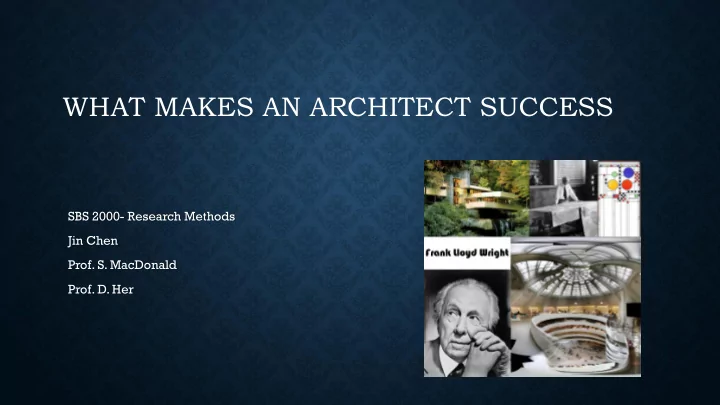

WHAT MAKES AN ARCHITECT SUCCESS SBS 2000- Research Methods Jin Chen Prof. S. MacDonald Prof. D. Her
WHY STUDYING THIS TOPIC? To reveal mysterious architect occupation • Better understanding practical architecture office • management Set up goals for students • Set up study guild line •
DEFINITION OF ARCHITECT OCCUPATION Dictionary definition.: a person who designs buildings and advises in their • construction • National Council of Architectural Registration Boards: Additionally, architects may be involved with designing the total built environment — from how a building integrates with its surrounding landscape to architectural or construction details that involve the interior of the building to designing and creating furniture to be used in a specific space .“ Royal Architectural Institute of Canada: Architects serve as trusted advisors, their • role is holistic, blending diverse requirements and disciplines in a creative process, while serving the public interest and addressing health and safety matters."
PRECEDENTS • Article "Architect Alvar Aalto Excelled By Design Focus On Form: Finnish master's eye for detail made him one of the world's premier architects“says architect need to work well on the detail design. Article "So you want to be an architect: you'll need design skills and artistic flair, plus the • ability to deliver on budget ." Near, Robert says architect is a “problem solver”, it requires architect to be able to design complicated details drawing, and socializing skills.
PRECEDENTS • Article , “Hire architect with skills in kind of design needed” the author says architect mainly work in three main catagories: * Architects save money by designing buildings to be efficient and economical; * Architects can guide the whole design and construction process because of their education, training and experience; and * Architects can sort through building codes and zoning laws as well as locate qualified contractors. • The book “Architect’s essentials of presentation skills” by David Greusel emphasizes the importance of presentation skill, because at most time architects (right brain thinker) assume that their drawings can talk by itself; however, most clients (typically left brain thinker) prefer verbal and analytical explanation.
RESEARCH METHODS Qualitative- focus group interview • Quantitative- survey •
FOCUS GROUP INTERVIEW DESIGN 1. Target group: architecture students 2. Set up interview questions: focus on what kind of skills they learned in school, and what they think of to work at an architecture office. 3. Interview and recording. 4. Aggregating the data from focus group using correlation analysis method: - count for the key phrases mentioned during interview. (i.e. computer software skills, artistic flair) 5. Identifying correlations between variables 6. Operationalizing variables- give definitions to key phrases
FOCUS GROUP INTERVIEW QUESTIONS 1. Why you choose architecture major? 2. What occupation do you want to be after you finish school education? 3. What do you think of to be an architect? 4. Talk about some positive learning experience in City Tech? 5. What classes do you think are useful, why? 6. Which class do you like best, why? 7. What kind of skills that you have learned from City Tech? Are they useful? How it apply to your path to achieve the goal in the future? 8. Do you have any suggestion on our school curriculum or school system?
SURVEY DESIGN 1. Target group: registered architects, college professors work in architecture field for years. 2. Set up survey questionnaire: use data collected from focus group interview, design questions using nominal, ordinal, interval, and ratio scales. 3. Survey process. 4. Aggregating the data: - count for the number of skills been checked. 5. Identifying correlations between variables
SURVEY QUESTIONNAIRE
CONCLUSION Analyze the data differences gathered from focus group • interview and survey research. Found out the gap between school education and real • working experiences.
BIBLIOGRAPHY http://micheleroohani.com/blog/wp-content/uploads/2009/08/frank-lloyd-wright- falling-water-guggenheim-michele-roohani-desing.jpg http://architecture.about.com/cs/buildyourhouse/g/architect.htm http://www.prwatch.org/files/images/confused-character.jpg
Recommend
More recommend